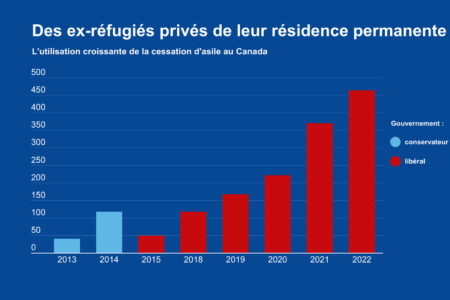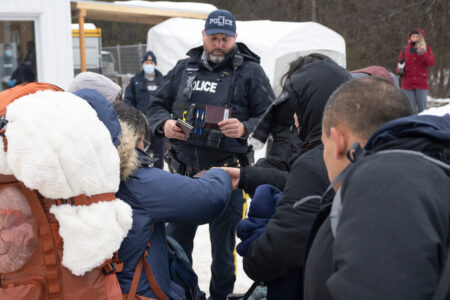
Between 1979 and 1981, 60,000 refugees from Vietnam, Laos and Cambodia came to Canada. I was the federal coordinator for the Indochinese movement in the Ontario region during those years. Today, I am actively engaged in the Syrian movement as a volunteer, and I often have occasion to compare the two.
Although as a member of civil society and not a civil servant my vantage point is different now, I firmly believe that many of the lessons learned from the Indochinese experience are still applicable to the current Syrian refugee movement, more than 35 years later. A conference and workshop held in 2013-14, organized by the Centre for Refugee Studies, the Canadian Immigration Historical Society and the Sponsorship Agreement Holders Council, brought together many of the major players in the Indochinese refugee movement.
A variety of papers and proposals for future movements were written by the conference organizing committee (Howard Adelman, Mike Molloy and myself), and were presented and discussed across the country in various fora and shared with federal civil servants.
It is far too early to assess fully the lessons from the Syrian movement, but the following is a very preliminary effort.
Policy matters: The legislation and policies have to be in place to allow action to be taken. Policies have to evolve to respond to changing needs.
In the Indochinese case, the immigration legislation allowing for the private sponsorship of refugees had recently been amended. As a result, more than half of all refugees from Vietnam, Cambodia and Laos were sponsored by private citizens. The new legislation also permitted the creation of “designated classes,” which enabled the efficient processing of refugees without requiring individual assessments of refugee claims.
In the Syrian case, it was only when the former government declared in 2015 that it would view all Syrians outside Syria as prima facie refugees that processing could take place expeditiously. The policy decision to conduct medical and security screening overseas before the refugees arrived in Canada addressed many public concerns about the movement, allowing the refugees to arrive in Canada as permanent residents so they were immediately eligible for all services and supports and ready to go directly to their final communities of destination.
Leadership matters: Leadership at the most senior government levels is essential to make things happen. This needs to be complemented by strong leadership in civil society and at the local level.
In the Indochinese case, both the Liberal government of Pierre Trudeau and the Progressive Conservative government of Joe Clark demonstrated extraordinary leadership, domestically and internationally, in selecting and resettling the refugees, in partnership with other levels of government, civil society and other stakeholders.
In the Syrian situation, it was only after the election that the federal government under the Liberals committed domestically and internationally to ambitious goals and targets, in collaboration with provinces, municipalities and civil society. As well, the Governor General brought key players together for an event in December 2015, which communicated a sense of national mission across a range of important sectors. Under the previous Conservative administration, Canada’s role was lacklustre at best, despite mounting concern on the part of individuals and institutions.
Trust in and respect for the civil service matters: This allows civil servants to make decisions, use discretion, and be flexible and innovative, so they can get the job done effectively.
The work done by the federal civil service during the Indochinese movement was creative and extremely effective — internationally and at the Ottawa national headquarters, as well as at the regional and local levels. Everyone was familiar with the goals and objectives and was given the authority to do what was necessary to achieve them. Political leaders trusted and respected the civil service, and the trust was reciprocated.
There was very little trust in the civil service under the previous administration. Processes had become extremely complicated and rule-bound, and risk aversion was ingrained at all levels of the organization. It was difficult for some public servants to make the cultural shift necessary to meet the objectives set by the new government for the Syrian movement.
Government structures matter: The organization of the federal department responsible for refugee resettlement makes a difference.
The organization and mandate of Employment and Immigration Canada in 1979-81 allowed for a continuum of action and consistent direction. Visa officers overseas; officers at the reception and matching centres; officers in local immigration centres; settlement, training and employment counsellors in local employment centres; as well as Employment Development Branch (EDB) community developers/refugee liaison officers were all in one department and reported to the same deputy minister/minister. This enabled quick coordination and collaboration to ensure the best use of resources and services. An internal task force led by the deputy minister allowed obstacles to be removed and resources to be allocated quickly to where they were needed.
By the time the Syrian crisis took place, there were no networks of immigration centres and employment centres across the country, the EDB no longer existed, responsibility for training and employment programs had been devolved to the provinces, and responsibility for reception, resettlement, and integration services had been devolved to a network of NGO service providers funded by the federal government through contribution agreements. While there are distinct advantages to the current system of NGO service providers, key elements (like sponsor support and monitoring, and community development) have fallen through the cracks or are not consistent across the country. Coordination is also more difficult; in many communities, there are no immigration department representatives at the table, because the department is no longer present in those communities.
The media matter: National and local media coverage plays a huge role in informing and engaging the public.
The Vietnam War and its aftermath were brought into the homes of Canadians through television. Images of people drowning in the sea as they tried to escape galvanized the nation. The government took its communication role seriously, and it had a multipronged internal and external communications strategy, relying heavily on proactive messaging to stakeholders and the media. Regular newsletters were distributed to all staff, the media, sponsor groups and other stakeholders, keeping them abreast of all developments.
Media coverage of the Syrian crisis generally started late in the game. However, once the refugees took to the seas to escape to Europe, and the photo of young Alan Kurdi laying face down on the beach caught the world’s attention, coverage increased exponentially. The Canadian public’s donation of money and goods and its interest in sponsoring refugees also increased. Syrian refugee resettlement became an election issue and was extensively covered by the media.
The previous administration under the Conservative government gave very little information to the media about its Syrian refugee resettlement efforts, and what it did provide was confusing. After the 2015 election, the Minister of Immigration and senior staff held regular briefings with the media and used social media, and a website was kept up to date regarding the resettlement efforts. The media continued to cover the refugee situation abroad, but they also began to focus on resettlement efforts in Canada.
Civil society matters: Canadians are good at finding workable solutions to complex problems.
The Indochinese movement engaged ordinary Canadians because they saw the positive impact of their tangible, practical involvement. This included a desire to have hands-on involvement with the refugees as sponsors and volunteers. The public felt they could influence the numbers of refugees Canada accepted, because for a time the government matched every refugee sponsored by private citizens, over and above the numbers Ottawa had identified as government-assisted refugees. Organizations like Operation Lifeline sprang up across the country to support sponsors and the refugees they sponsored.
In the Syrian movement, average Canadians have come forward in droves to sponsor refugees. The Liberal platform during the election period committed to bringing in 25,000 government-assisted refugees, and it provided no ceiling for privately sponsored refugees above that figure. When the government met its target of 25,000 refugees in February, Canadians with sponsorship applications in the pipeline became concerned that the commitment to quick processing was waning, and that the government had placed a cap on the number of refugees. Sponsor groups were outraged when they were told that they would have to wait until 2017 before the refugees they sponsored would come to Canada. In response to these concerns, the government announced that all private sponsorship applications submitted by March 31, 2016, would be processed no later than early 2017. The government will have to find ways to respond to civil society’s increased willingness to engage in refugee resettlement, or it may lose all the benefits that come with it.
Multi-stakeholder partnerships and collaboration at the international, national, provincial and local levels matter: These partnerships must be based on common goals, trust and respect.
The federal government used its networks and created new ones during the Indochinese movement. This included relationships with the UN Refugee Agency, the International Organization for Migration, and other major resettlement countries. Having regional and local staff helped considerably in developing partnerships in Canada with provinces, municipalities and local stakeholders. In the region of Ontario, for example, there was an intergovernmental planning group, chaired by the immigration department, which included the major federal departments, the provincial government, the City of Toronto and major settlement organizations.
The administration under the Conservative government did not focus on multi-stakeholder partnerships and collaboration on the Syrian refugee file until the election campaign, when it appointed two coordinators— one internal and one external— for the initiative. Both were very effective in their roles at the international, national, and federal/provincial levels, particularly after the election, when the modus operandi changed dramatically under the incoming government. Regional officials were effective as well, but there were limited staff at the local level, and the network of resettlement and settlement service providers felt that they were not consulted early enough in the process. Sponsor groups that were not directly associated with the organizations that had umbrella sponsorship agreements with the federal government, which were primarily faith-based and ethnic, were often left outside the loop.
Implementation on the ground matters: Working with communities to prepare them for the movement and responding quickly to emerging situations helps prevent serious problems.
During the Indochinese movement, a network of federally employed refugee liaison officers — experienced community development workers — was stationed across the country. They were the local facilitators, conveners, trouble-shooters and interveners, who worked with local governments and stakeholders to identify issues and gaps in services and develop local solutions. There were also local immigration and employment centre employees who reported on concerns as they arose and could intervene if necessary. Information about emerging problems moved rapidly and unimpeded between the local, regional and federal levels.
For the Syrian movement, there are no federal staff members at the local level. Local leadership is provided by a variety of bodies: in some communities, they are federally funded service providers, in others, it is the local municipality, and in still others, they are existing or new civil society organizations. While the Resettlement Assistance Program (funded by the federal government) is very experienced and competent and deals with steady flows of refugees, it was under-resourced to manage the huge intake of refugees and the huge number of people wishing to help in such a short time. Regular conference calls with federal officials helped keep the feedback loops open so corrective action could be taken.
Families matter: Keeping families intact and facilitating family reunification is critically important for effective refugee resettlement.
In the Indochinese movement, visa officers were instructed to select entire family groupings, regardless of the degree of relationship. “No family member left behind” was the operational instruction. This led to more families coming to Canada intact, who were better able to help each other in their resettlement and were not preoccupied about those left behind. Later, an “orderly departure program” allowed family members still in Vietnam to be reunited with their families in Canada directly without the risk of having to escape to a country of first asylum. Visa officers used discretionary authority generously for several years to facilitate the admission of relatives outside the immigration regulations’ definition of nuclear family (spouse, minor children, and parents).
In the Syrian movement, there are variations in how Canada receives and accepts linked family groupings. There does not seem to be a consistent approach. The sponsorship applications for extended families are complicated and often have requirements that do not recognize existing kinship ties. For example, sponsors are expected to raise enough funds to pay for housing for unmarried adult children, even though they expect to live with their parents in Canada. The current private sponsorship program may not be the best way to satisfy the need for family reunification, and a special program for that purpose should be designed.
Intercultural personal contact matters: Direct personal contact between ordinary Canadians and refugees can be magical for all involved and leads to cross-cultural learning, respect, friendship and real two-way integration.
Evaluations of the Indochinese refugee movement demonstrated that those with private sponsors were integrated and became employed more quickly. They benefitted from their sponsors’ social and professional networks, which gave the refugees social capital that they would not have had otherwise. Their sponsors became their advocates, and in many cases, their friends. Most government-assisted refugees were matched with volunteer host families, who performed some of the functions that sponsors did without the added financial responsibilities.
With the Syrian movement, most privately sponsored refugees are identified by their Syrian Canadian friends or family members in Canada. In some cases, most of the human support will be provided by the family members, and the Canadian sponsors may play more of a financial role. In other cases, the sponsors will establish relationships with and support the Syrian-Canadian contacts and the refugee family. Government-assisted refugees get financial support from the government, and they get orientation, counselling and referrals from the federally funded service-provider organizations. The use of volunteers varies among these organizations. It is far too early to assess the outcomes, but anecdotal information to date would suggest that all refugees, whether government assisted or privately sponsored, would benefit from having access to the expertise of the settlement sector, as well as to personal support and intercultural contact with average Canadians, whether they are sponsors or volunteers.
The Syrian refugee movement is still very much a project in process, with more families coming and beginning their settlement journey every day. We’re only beginning to identify the lessons particular to this movement. But it is clear that many of the lessons from the previous Indochinese movement apply today.
I witnessed first hand the amazing resilience of the Indochinese refugees, who went on to make enormous contributions to Canada, in the first and second generations. Many of them are now sponsoring Syrian refugees, as am I. When I interact with the Syrian family my group is sponsoring and see the amazing resilience that I saw so many years ago, I am confident that, with the proper supports, they too will add immeasurably to Canada’s future.
Photo: THE CANADIAN PRESS / John Goddard
This article is part of the Refugee Integration special feature.
Do you have something to say about the article you just read? Be part of the Policy Options discussion, and send in your own submission. Here is a link on how to do it. | Souhaitez-vous réagir à cet article ? Joignez-vous aux débats d’Options politiques et soumettez-nous votre texte en suivant ces directives.






